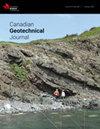物理化学过程在砂土中钢桩轴摩擦老化中的作用
IF 3.5
3区 工程技术
Q2 ENGINEERING, GEOLOGICAL
引用次数: 0
摘要
一些研究报告说,在安装后的几个月里,打入钢桩的竖井容量大幅增加。本文采用新研制的试验装置,进行了一系列现场桩身试验和平行系列界面剪切试验,探讨了影响轴承载力时间依赖性的因素。试验桩和界面采用低碳钢、不锈钢和镀锌钢,实验室和现场允许老化期分别为1年和3年。报道了在砂-钢界面处形成的结壳的化学分析。结果表明,砂-钢摩擦的老化特性取决于互锁和剪胀的相对贡献,而受桩身附近砂壳界面处的剪胀控制。在干砂中或在无反应钢桩中,随着时间的推移,轴的摩擦力没有增加。湿、饱和砂土中低碳钢桩的运行摩擦角为土-土摩擦角。本文章由计算机程序翻译,如有差异,请以英文原文为准。
The role of physicochemical processes in ageing of shaft friction of driven steel piles in sand
Several studies have reported substantial increases in the shaft capacity of driven steel piles in the months following installation. This paper investigates factors influencing this time dependence of shaft capacity by conducting a series of field tests on piles and a parallel series of interface shear tests using a newly developed apparatus. The piles and interfaces used in the experiments employ mild steel, stainless steel and galvanised steel, while the ageing periods allowed in the laboratory and field were 1 and 3 years respectively. Chemical analyses of the crusts that developed at the sand-steel interfaces are reported. It is shown that the ageing characteristic of sand-steel friction depends on the relative contributions of interlocking and dilation but is controlled by dilation at the crust-sand interface adjacent to the shaft of a driven pile. There is no gain in shaft friction with time in dry sand or for piles with non-reactive steel. The operational friction angle for mild steel piles in moist or saturated sand is the soil-soil friction angle.
求助全文
通过发布文献求助,成功后即可免费获取论文全文。
去求助
来源期刊

Canadian Geotechnical Journal
地学-地球科学综合
CiteScore
7.20
自引率
5.60%
发文量
163
审稿时长
7.5 months
期刊介绍:
The Canadian Geotechnical Journal features articles, notes, reviews, and discussions related to new developments in geotechnical and geoenvironmental engineering, and applied sciences. The topics of papers written by researchers and engineers/scientists active in industry include soil and rock mechanics, material properties and fundamental behaviour, site characterization, foundations, excavations, tunnels, dams and embankments, slopes, landslides, geological and rock engineering, ground improvement, hydrogeology and contaminant hydrogeology, geochemistry, waste management, geosynthetics, offshore engineering, ice, frozen ground and northern engineering, risk and reliability applications, and physical and numerical modelling.
Contributions that have practical relevance are preferred, including case records. Purely theoretical contributions are not generally published unless they are on a topic of special interest (like unsaturated soil mechanics or cold regions geotechnics) or they have direct practical value.
 求助内容:
求助内容: 应助结果提醒方式:
应助结果提醒方式:


